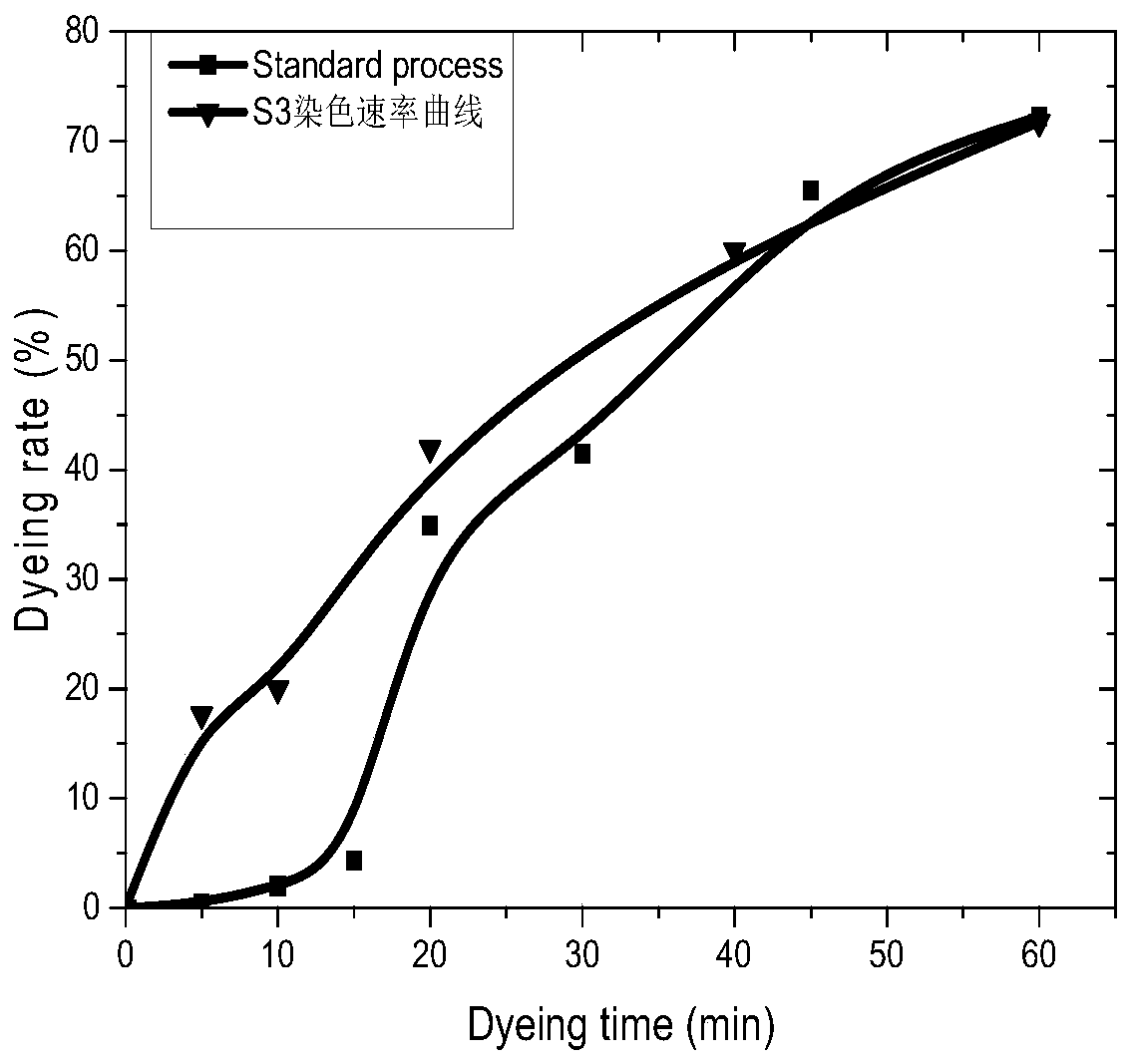Low-salt dyeing method of reactive dye
A technology of reactive dyes and dyeing methods, applied in the field of full-bath pre-modification of cellulose fibers and low-salt dyeing, which can solve the problem of limited salt consumption of reactive dyes in ultrasonic dyeing machines, impossibility of industrial application, and stable dyeing effect Poor performance and other problems, achieve the effect of small modification effect, increase K/S value, and inhibit hydrolysis
- Summary
- Abstract
- Description
- Claims
- Application Information
AI Technical Summary
Problems solved by technology
Method used
Image
Examples
Embodiment 1
[0047] The raw materials for this dyeing process include:
[0048] 1. Fabric to be dyed: pure cotton bleached cloth 1000g
[0049] 2. Reactive dye: Huntsman NOVACRON DEEP NIGHT S-R 20g
[0050] 3. Neutral electrolyte: 200g of anhydrous sodium sulfate (ie 20g / L)
[0051] 4. Inorganic base: sodium carbonate 130g (ie 13g / L)
[0052] 5. Fiber modifier: with 2 C 12 Fatty long chain diquaternary ammonium salt 4g
[0053] 6. Demineralized water: the total hardness is 25ppmCaCO 3 Soft water 10000g
[0054] The specific steps of the dyeing process:
[0055] (1) The step of pretreatment of cotton textiles to be dyed: in this step, the cotton textiles to be dyed, demineralized water, fiber modifier, and pH regulator are mixed, and the cotton textiles to be dyed are modified to obtain modified cotton textiles to be dyed ,Specifically:
[0056] (1.1) Put 90wt% of the total amount of demineralized water and the fiber modifier into the dyeing machine, adjust the pH to 4.5, put into t...
Embodiment 2
[0068] The raw materials for this dyeing process include:
[0069] 1. Fabric to be dyed: pure cotton bleached cloth 1000g
[0070] 2. Reactive dye: reactive brilliant blue KN-R 40g
[0071] 3. Neutral electrolyte: anhydrous sodium sulfate 300g (ie 30g / L)
[0072] 4. Inorganic base: sodium carbonate 160g (ie 16g / L)
[0073] 5. Fiber modifier: with 2 C 12 Fatty long chain diquaternary ammonium salt 5.5g
[0074] 6. Demineralized water: the total hardness is 25ppmCaCO 3 Soft water 10000g
[0075] The specific steps of the dyeing process:
[0076] (1) The step of pretreatment of cotton textiles to be dyed: in this step, the cotton textiles to be dyed, demineralized water, fiber modifier, and pH regulator are mixed, and the cotton textiles to be dyed are modified to obtain modified cotton textiles to be dyed ,Specifically:
[0077] (1.1) Put 90wt% of the total amount of demineralized water and the fiber modifier into the dyeing machine, adjust the pH to 5, put into the cott...
Embodiment 3
[0089] The raw materials for this dyeing process include:
[0090] 1. Fabric to be dyed: pure cotton bleached cloth 1000g
[0091] 2. Reactive dye: reactive black RGB 60g
[0092] 3. Neutral electrolyte: 400g of anhydrous sodium sulfate (ie 40g / L)
[0093] 4. Inorganic base: sodium carbonate 190g (ie 19g / L)
[0094] 5. Fiber modifier: with 1 C 10 Fatty long chain monoquaternary ammonium salt 6g
[0095] 6. Demineralized water: the total hardness is 25ppmCaCO 3 Soft water 10000g
[0096] The specific steps of the dyeing process:
[0097] (1) The step of pretreatment of cotton textiles to be dyed: in this step, the cotton textiles to be dyed, demineralized water, fiber modifier, and pH regulator are mixed, and the cotton textiles to be dyed are modified to obtain modified cotton textiles to be dyed ,Specifically:
[0098] (1.1) Put 90wt% of the total amount of demineralized water and fiber modifier into the dyeing machine, adjust the pH to 4.5-5, put into the cotton textil...
PUM
 Login to View More
Login to View More Abstract
Description
Claims
Application Information
 Login to View More
Login to View More - R&D
- Intellectual Property
- Life Sciences
- Materials
- Tech Scout
- Unparalleled Data Quality
- Higher Quality Content
- 60% Fewer Hallucinations
Browse by: Latest US Patents, China's latest patents, Technical Efficacy Thesaurus, Application Domain, Technology Topic, Popular Technical Reports.
© 2025 PatSnap. All rights reserved.Legal|Privacy policy|Modern Slavery Act Transparency Statement|Sitemap|About US| Contact US: help@patsnap.com

